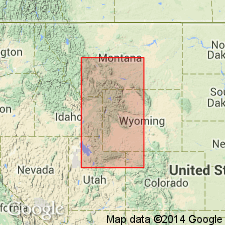
- Usage in publication:
-
- Tosi chert member*
- Modifications:
-
- Named
- Dominant lithology:
-
- Chert
- AAPG geologic province:
-
- Green River basin
Summary:
Named (Sheldon, p. 30-31) as a member of Phosphoria formation for exposures on Tosi Creek, Sublette Co, WY in Greater Green River basin. Type section measured in SE1/4 sec 17,, T39N, R110W. Occurs also in Montana folded belt province, MT, Yellowstone province, Bighorn and Wind River basins, WY, Snake River basin, ID, and Wasatch uplift, UT. Is composed of brownish-gray to light gray, thin- to thick-bedded, hard, usually medium crystalline chert 32.7 ft thick at type. Thickens northward to 40 ft in Yellowstone park, WY and to 145 ft thick in Beaverhead Co, MT. Is 70 ft thick in Wind River Mountains and about 15 ft thick in Owl Creek Mountains, WY. Overlies Retort phosphatic shale member of Phosphoria; underlies upper tongue of Shedhorn sandstone at type. Is a marine unit. Contains a varied bryozoan and brachiopod fauna.
Source: GNU records (USGS DDS-6; Denver GNULEX).
For more information, please contact Nancy Stamm, Geologic Names Committee Secretary.
Asterisk (*) indicates published by U.S. Geological Survey authors.
"No current usage" (†) implies that a name has been abandoned or has fallen into disuse. Former usage and, if known, replacement name given in parentheses ( ).
Slash (/) indicates name conflicts with nomenclatural guidelines (CSN, 1933; ACSN, 1961, 1970; NACSN, 1983, 2005, 2021). May be explained within brackets ([ ]).

